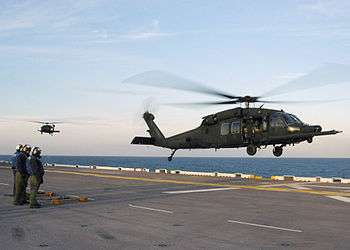Sikorsky UH-60 Black Hawk
The Sikorsky UH-60 Black Hawk is a four-blade, twin-engine, medium-lift utility helicopter manufactured by Sikorsky Aircraft. Sikorsky submitted the S-70 design for the United States Army's Utility Tactical Transport Aircraft System (UTTAS) competition in 1972. The Army designated the prototype as the YUH-60A and selected the Black Hawk as the winner of the program in 1976, after a fly-off competition with the Boeing Vertol YUH-61.
| UH-60 Black Hawk | |
|---|---|
.jpg) | |
| A UH-60 Black Hawk from the 2nd Cavalry Regiment of United States Army Europe. | |
| Role | Utility helicopter |
| Manufacturer | Sikorsky Aircraft |
| First flight | 17 October 1974 |
| Introduction | 1979 |
| Status | In service |
| Primary users | United States Army Japan Self Defense Forces Colombian Armed Forces Republic of Korea Armed Forces |
| Produced | 1974–present |
| Number built | About 4,000[1] |
| Unit cost |
UH-60: US$21.3 million (avg. U.S. procurement, 2012)[2] |
| Developed from | Sikorsky S-70 |
| Variants | Sikorsky SH-60 Seahawk Sikorsky HH-60 Pave Hawk Sikorsky HH-60 Jayhawk Mitsubishi H-60 |
Named after the Native American war leader Black Hawk, the UH-60A entered service with the U.S. Army in 1979, to replace the Bell UH-1 Iroquois as the Army's tactical transport helicopter. This was followed by the fielding of electronic warfare and special operations variants of the Black Hawk. Improved UH-60L and UH-60M utility variants have also been developed. Modified versions have also been developed for the U.S. Navy, Air Force, and Coast Guard. In addition to U.S. Army use, the UH-60 family has been exported to several nations. Black Hawks have served in combat during conflicts in Grenada, Panama, Iraq, Somalia, the Balkans, Afghanistan, and other areas in the Middle East.
Development
Initial requirement
In the late 1960s, the United States Army began forming requirements for a helicopter to replace the UH-1 Iroquois, and designated the program as the Utility Tactical Transport Aircraft System (UTTAS). The Army also initiated the development of a new, common turbine engine for its helicopters that would become the General Electric T700. Based on experience in Vietnam, the Army required significant performance, survivability and reliability improvements from both UTTAS and the new powerplant.[3] The Army released its UTTAS request for proposals (RFP) in January 1972.[4] The RFP also included air transport requirements. Transport within the C-130 limited the UTTAS cabin height and length.[5]
The UTTAS requirements for improved reliability, survivability and lower life-cycle costs resulted in features such as dual-engines with improved hot and high altitude performance, and a modular design (reduced maintenance footprint); run-dry gearboxes; ballistically tolerant, redundant subsystems (hydraulic, electrical and flight controls); crashworthy crew (armored) and troop seats; dual-stage oleo main landing gear; ballistically tolerant, crashworthy main structure; quieter, more robust main and tail rotor systems; and a ballistically tolerant, crashworthy fuel system.[6]
Four prototypes were constructed, with the first YUH-60A flying on 17 October 1974. Prior to delivery of the prototypes to the US Army, a preliminary evaluation was conducted in November 1975 to ensure the aircraft could be operated safely during all testing.[7] Three of the prototypes were delivered to the Army in March 1976, for evaluation against the rival Boeing-Vertol design, the YUH-61A, and one was kept by Sikorsky for internal research. The Army selected the UH-60 for production in December 1976. Deliveries of the UH-60A to the Army began in October 1978 and the helicopter entered service in June 1979.[8]
Upgrades and variations
After entering service, the helicopter was modified for new missions and roles, including mine laying and medical evacuation. An EH-60 variant was developed to conduct electronic warfare and special operations aviation developed the MH-60 variant to support its missions.[9]
Due to weight increases from the addition of mission equipment and other changes, the Army ordered the improved UH-60L in 1987. The new model incorporated all of the modifications made to the UH-60A fleet as standard design features. The UH-60L also featured more power and lifting capability with upgraded T700-GE-701C engines and an improved gearbox, both from the SH-60B Seahawk.[10] Its external lift capacity increased by 1,000 lb (450 kg) up to 9,000 lb (4,100 kg). The UH-60L also incorporated the SH-60B's automatic flight control system (AFCS) for better flight control with the more powerful engines.[11] Production of the L-model began in 1989.[10]
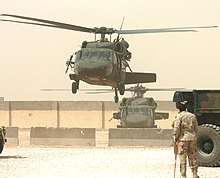
Development of the next improved variant, the UH-60M, was approved in 2001, to extend the service life of the UH-60 design into the 2020s. The UH-60M incorporates upgraded T700-GE-701D engines, improved rotor blades, and state of the art electronic instrumentation, flight controls and aircraft navigation control. After the U.S. DoD approved low-rate initial production of the new variant,[12] manufacturing began in 2006,[13] with the first of 22 new UH-60Ms delivered in July 2006.[14] After an initial operational evaluation, the Army approved full-rate production and a five-year contract for 1,227 helicopters in December 2007.[15] By March 2009, 100 UH-60M helicopters had been delivered to the Army.[16] In November 2014, US military ordered 102 aircraft of various H-60 types, worth $1.3 billion.[17]
Following an operation in May 2011, it emerged that the 160th SOAR used a secret version of the UH-60 modified with low-observable technology which enabled it to evade Pakistani radar. Analysis of the tail section, the only remaining part of the aircraft which crashed during the operation,[18][19] revealed extra blades on the tail rotor and other noise reduction measures, making the craft much quieter than conventional UH-60s. The aircraft appeared to include features like special high-tech materials, harsh angles, and flat surfaces found only in stealth jets.[Nb 1][20] Low observable versions of the Black Hawk have been studied as far back as the mid-1970s.[21]
In September 2012, Sikorsky was awarded a Combat Tempered Platform Demonstration (CTPD) contract to further improve the Black Hawk's durability and survivability. The company is to develop new technologies such as a zero-vibration system, adaptive flight control laws, advanced fire management, a more durable main rotor, full-spectrum crashworthiness, and damage tolerant airframe; then they are to transition them to the helicopter. Improvements to the Black Hawk are to continue until the Future Vertical Lift program is ready to replace it.[22][23]
In December 2014, the 101st Airborne Division began testing new resupply equipment called the Enhanced Speed Bag System (ESBS). Soldiers pinned down in the field requiring quick resupply have depended on speed bags, bags filled with items airdropped from a UH-60. However, all systems were ad-hoc with bags not made to keep things secure from impacts, so up to half of the airdropped items would be damaged upon hitting the ground. Started in 2011, the ESBS sought to standardize the airdrop resupply method and keep up to 90 percent of supplies intact. The system includes a hands-free reusable linear brake and expendable speed line and multipurpose cargo bag; when the bag is deployed, the brake applies friction to the rope, slowing it down enough to keep the bag oriented down on the padded base, a honeycomb and foam kit inside to dissipate energy. The ESBS not only better protects helicopter-dropped supplies, it allows the Black Hawk to fly higher above the ground, 100 ft (30 m) up from 10 feet, while traveling 20 knots (23 mph; 37 km/h), limiting exposure to ground fire. Each bag can weigh 125–200 lb (57–91 kg) and up to six can be deployed at once, dropping 40–50 feet per second (12–15 m/s). Since supplies can be delivered more accurately and the system can be automatically released on its own, the ESBS can enable autonomous resupply from unmanned helicopters.[24][25][26]
Design
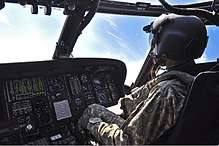
The UH-60 features four-blade main and tail rotors, and is powered by two General Electric T700 turboshaft engines.[27] The main rotor is fully articulated and has elastomeric bearings in the rotor head. The tail rotor is canted and features a rigid crossbeam.[28] The helicopter has a long, low profile shape to meet the Army's requirement for transporting aboard a C-130 Hercules, with some disassembly.[27] It can carry 11 troops with equipment, lift 2,600 pounds (1,200 kg) of cargo internally or 9,000 pounds (4,100 kg) of cargo (for UH-60L/M) externally by sling.[15]
The Black Hawk helicopter series can perform a wide array of missions, including the tactical transport of troops, electronic warfare, and aeromedical evacuation. A VIP version known as the VH-60N is used to transport important government officials (e.g., Congress, Executive departments) with the helicopter's call sign of "Marine One" when transporting the President of the United States.[29] In air assault operations, it can move a squad of 11 combat troops or reposition a 105 mm M119 howitzer with 30 rounds ammunition, and a four-man crew in a single lift.[15] The Black Hawk is equipped with advanced avionics and electronics for increased survivability and capability, such as the Global Positioning System.
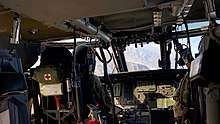
The UH-60 can be equipped with stub wings at the top of fuselage to carry fuel tanks or various armaments. The initial stub wing system is called External Stores Support System (ESSS).[30] It has two pylons on each wing to carry two 230 US gal (870 L) and two 450 US gal (1,700 L) tanks in total.[11] The four fuel tanks and associated lines and valves form the external extended range fuel system (ERFS).[31] U.S. Army UH-60s have had their ESSS modified into the crashworthy external fuel system (CEFS) configuration, replacing the older tanks with up to four total 200 US gal (760 L) crashworthy tanks along with self-sealing fuel lines.[32] The ESSS can also carry 10,000 lb (4,500 kg) of armament such as rockets, missiles and gun pods.[11][33] The ESSS entered service in 1986. However, it was found that the four fuel tanks obstruct the field of fire for the door guns; thus, the external tank system (ETS), carrying two fuel tanks on the stub wings, was developed.[11]
The unit cost of the H-60 models varies due to differences in specifications, equipment and quantities. For example, the unit cost of the Army's UH-60L Black Hawk is $5.9 million while the unit cost of the Air Force HH-60G Pave Hawk is $10.2 million.[34]
Operational history
Australia
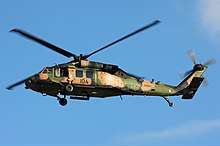
Australia has 20 Black Hawks as of 2019. It has deployed the aircraft to East Timor[35] and the Solomon Islands.[36] It did not deploy Black Hawks to Afghanistan because Angus Houston, the then-defence chief, advised the government that the aircraft lacked armour and self-defence systems.[37]
Brazil
Brazil received four UH-60L helicopters in 1997, for the Brazilian Army peacekeeping forces. It received six UH-60Ls configured for special forces, and search and rescue uses in 2008. It ordered ten more UH-60Ls in 2009; deliveries began in March 2011.[38]
China
In December 1983, examples of the Aerospatiale AS-332 Super Puma, Bell 214ST SuperTransport and Sikorsky S-70A-5 (N3124B) were airlifted to Lhasa for testing. These demonstrations included take-offs and landings at altitudes to 17,000 feet (5,200 m) and en route operations to 24,000 feet (7,300 m). At the end of this testing, the People's Liberation Army Air Force purchased 24 S-70C-2s, equipped with more powerful GE T700-701A engines for improved high-altitude performance.[39] While designated as civil variants of the S-70 for export purposes, they are operated by the People's Liberation Army Air Force.
Colombia
Colombia first received UH-60s from the United States in 1987. The Colombian National Police, Colombian Air Force, and Colombian Army use UH-60s to transport troops and supplies to places which are difficult to access by land for counter-insurgency (COIN) operations against drug and guerrilla organizations, for search and rescue, and for medical evacuation. Colombia also operates a militarized gunship version of the UH-60, with stub wings, locally known as Arpía (English: Harpy).[40][41]
The Colombian Army became the first worldwide operator of the S-70i with Terrain Awareness and Warning Capability (HTAWS) after taking delivery of the first two units on 13 August 2013.[42]
In March 2017, the National Police of Colombia ordered 10 additional UH-60 helicopters that will increase their total to 19 helicopters in operation.[43]
Israel
The Israeli Air Force (IAF) received 10 surplus UH-60A Black Hawks from the United States in August 1994.[44] Named Yanshuf (English: Owl) by the IAF,[45] the UH-60A began replacing Bell 212 utility helicopters.[44] The IAF first used the UH-60s in combat during 1996 in southern Lebanon[44] in Operation "Grapes of Wrath" against Hezbollah.
Mexico
The Mexican Air Force ordered its first two UH-60Ls in 1991, to transport special forces units, and another four in 1994.[46] In July and August 2009, the Federal Police used UH-60s in attacks on drug traffickers.[47][48] In August 2011, the Mexican Navy received three upgraded and navalized UH-60M.[49] On 21 April 2014, the U.S. State Department approved the sale of 18 UH-60Ms to Mexico pending approval from Congress.[50] In September 2014, Sikorsky received a $203.6 million firm-fixed-price contract modification for the 18 UH-60 designated for the Mexican Air Force.[51]
Slovakia
In February 2015, the U.S. State Department approved a possible Foreign Military Sale of nine UH-60Ms with associated equipment and support to Slovakia and sent to Congress for its approval.[52][53] In April 2015, Slovakia's government approved the procurement of nine UH-60Ms along with training and support.[54][55] In September 2015, Slovakia ordered four UH-60Ms.[56] The first two UH-60Ms were delivered in June 2017 and by January 2020 the Slovak Air Force had received nine UH-60Ms. These replace its old Soviet Mil Mi-17s.[57][58][59]
Slovak Training Academy from Košice, a private company, operates four older UH-60As for new pilot training.[60]
Sweden
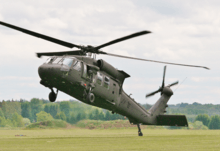
Sweden requested 15 UH-60M helicopters by Foreign Military Sale in September 2010.[61] The UH-60Ms were ordered in May 2011, and deliveries began in January 2012.[62] In March 2013, Swedish ISAF forces began using Black Hawks in Afghanistan for MEDEVAC purposes.[63] The UH-60Ms are to be fully operational by 2017.[64]
Taiwan
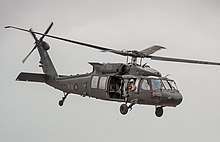
Taiwan (Republic of China) operated S-70C-1/1A after the Republic of China Air Force received ten S-70C-1A and four S-70C-1 Bluehawk helicopters in June 1986 for Search and Rescue.[65] Four more S-70C-6s were received in April 1998. The ROC Navy received the first of ten S-70C(M)-1s in July 1990. 11 S-70C(M)-2s were received beginning April 2000.[66] In January 2010, the US announced approval for a Foreign Military Sale of 60 UH-60Ms to Taiwan[67] with 30 designated for the Army, 15 for the National Airborne Service Corps (including the one that crashed off Orchid Island in 2018) and 15 for the Air Force Rescue Group (including the one that crashed 2 January 2020).[68]
Turkey
Turkey has operated the UH-60 during NATO deployments to Afghanistan and the Balkans. The UH-60 has also been used in counter-terror/internal security operations.
The Black Hawk competed against the AgustaWestland AW149 in the Turkish General Use Helicopter Tender, to order up to 115 helicopters and produce many of them indigenously, with Turkish Aerospace Industries responsible for final integration and assembly.[69][70] On 21 April 2011, Turkey announced the selection of Sikorsky's T-70.[71][72][73]
In the course of the coup d'état attempt in Turkey on 15 July 2016, eight Turkish military personnel of various ranks landed in Greece′s northeastern city of Alexandroupolis on board the Black Hawk helicopter and claimed political asylum in Greece.[74] The helicopter was returned to Turkey shortly thereafter.[75]
United States
The UH-60 entered service with the U.S. Army's 101st Combat Aviation Brigade of the 101st Airborne Division in June 1979.[76] The U.S. military first used the UH-60 in combat during the invasion of Grenada in 1983, and again in the invasion of Panama in 1989. During the Gulf War in 1991, the UH-60 participated in the largest air assault mission in U.S. Army history with over 300 helicopters involved. Two UH-60s (89-26214 and 78-23015) were shot down, both on 27 February 1991, while performing Combat Search and Rescue of other downed aircrews, an F-16C pilot and the crew of a MEDEVAC UH-1H that were shot down earlier that day.[77]

In 1993, Black Hawks featured prominently in the assault on Mogadishu in Somalia. Black Hawks also saw action in the Balkans and Haiti in the 1990s.[11] U.S. Army UH-60s and other helicopters conducted many air assault and other support missions during the 2003 invasion of Iraq. The UH-60 has continued to serve in operations in Afghanistan and Iraq.[11]
Customs and Border Protection Office of Air and Marine (OAM) uses the UH-60 in its operations specifically along the southwest border. The Black Hawk has been used by OAM to interdict illegal entry into the U.S. Additionally, OAM regularly uses the UH-60 in search and rescue operations.
Highly modified H-60s were employed during the U.S. Special Operations mission that resulted in the death of Osama bin Laden during Operation Neptune Spear on 1 May 2011.[20][78] One such MH-60 helicopter crash-landed during the operation, and was destroyed by the team before it departed in the other MH-60 and a backup MH-47 Chinook with bin Laden's remains. Two MH-47s were used for the mission to refuel the two MH-60s and as backups.[79] News media reported that the Pakistani government granted the Chinese military access to the wreckage of the crashed 'stealth' UH-60 variant in Abbotabad;[80][81][82] Pakistan and China denied the reports,[80][81] and the U.S. Government has not confirmed Chinese access.[81]
Other and potential users
The United Arab Emirates requested 14 UH-60M helicopters and associated equipment in September 2008, through Foreign Military Sale.[83] It had received 20 UH-60Ls by November 2010.[84] Bahrain ordered nine UH-60Ms in 2007.[85][86]
In December 2011, the Royal Brunei Air Force ordered twelve S-70i helicopters, which are similar to the UH-60M; four aircraft had been received by December 2013.[87] On 12 June 2012, the U.S. Defense Security Cooperation Agency notified Congress that Qatar requested the purchase of twelve UH-60Ms, engines, and associated equipment.[88]
On 25 February 2013, the Indonesian Army announced its interest in buying UH-60 Black Hawks as part of its effort to modernize its weaponry. The army wants them for combating terrorism, transnational crime, and insurgency to secure the archipelago.[89]
On 27 May 2014, Croatian Defence Minister Ante Kotromanović announced the beginning of negotiations for the purchase of 15 used Black Hawks.[90] On 12 October 2018, the US via Ambassador Robert Kohorst donated two UH-60M helicopters with associated equipment and crew training to Croatia's Ministry of Defence. The helicopters are to be delivered in 2020.[91]
Tunisia requested 12 armed UH-60M helicopters in July 2014 through Foreign Military Sale.[92] In August 2014, the U.S. ambassador stated that the U.S. "will soon make available" the UH-60Ms to Tunisia.[93]
On 23 January 2015, the Malaysian Defence Minister Hishammuddin Hussein confirmed that Royal Malaysian Air Force (RMAF) is receiving S-70A Blackhawks from the Brunei government. These helicopters, believed to be four in total, were expected to be transferred to Malaysia by September with M134D miniguns added. The four Blackhawks were delivered to Royal Brunei Air Force (RBAF) in 1999.[94]
In 2018, Latvia requested to buy four UH-60M Black Hawk helicopters with associated equipment for an estimated cost of $200 million. On 3 August 2018, the State Department approved the possible Foreign Military Sale. The Defense Security Cooperation Agency delivered the required certification notifying Congress of the possible sale.[95] In November 2018, Latvia signed for the purchase of four UH-60 helicopters. Deliveries are to be completed by 2021.[96]
On 7 December 2018, the Philippine Defense Secretary Delfin Lorenzana, revealed that the Philippine Air Force Technical Working Group recommended the UH-60 Blackhawk for its combat utility helicopter acquisition project[97] to be used for supply transport.[98] On Match, 2019, the Philippines’ Department of National Defense (DND) signed a contract worth US$241.4 million with Lockheed Martin's Polish subsidiary PZL Mielec to deliver 16 units of Sikorsky's S-70i Black Hawk combat utility helicopters for the Philippine Air Force (PAF). The deal between the two parties was signed last March 2019, and the Notice to Proceed (NTP) was provided by DND to PZL Mielec by 16 April 2019.[99]
In 2019, Lithuania requested to buy six UH-60M Black Hawk helicopters for an estimated cost of $300 million.[100] In the same year, Poland was also set to acquire four UH-60M Black Hawk helicopters for its special forces.[101]
Variants
The UH-60 comes in many variants, and many different modifications. The U.S. Army variants can be fitted with the stub wings to carry additional fuel tanks or weapons.[11] Variants may have different capabilities and equipment to fulfill different roles.
Utility variants
- YUH-60A: Initial test and evaluation version for U.S. Army. First flight on 17 October 1974; three built.
- UH-60A Black Hawk: Original U.S. Army version, carrying a crew of four and up to 11 equipped troops.[102] Equipped with T700-GE-700 engines.[103] Produced 1977–1989. U.S. Army is equipping UH-60As with more powerful T700-GE-701D engines and also upgrading A-models to UH-60L standard.[104]
- UH-60C Black Hawk: Modified version for command and control (C2) missions.[11][103]
- CH-60E: Proposed troop transport variant for the U.S. Marine Corps.[105]
- UH-60L Black Hawk: UH-60A with upgraded T700-GE-701C engines, improved durability gearbox, and updated flight control system.[11] Produced 1989–2007.[106] UH-60Ls are also being equipped with the GE T700-GE-701D engine.[104] The U.S. Army Corpus Christi Army Depot is upgrading UH-60A helicopters to the UH-60L configuration. In July 2018, Sierra Nevada Corporation proposed upgrading some converted UH-60L helicopters for the U.S. Air Force's UH-1N replacement program.[107]
- UH-60V Black Hawk: Upgraded version of the UH-60L with the electronic displays (glass cockpit) of the UH-60M. Upgrades performed by Northrop Grumman featuring a centralized processor with a partitioned, modular operational flight program enabling capabilities to be added as software-only modifications.[108]
- UH-60M Black Hawk: Improved design wide chord rotor blades, T700-GE-701D engines (max 2,000 shp or 1,500 kW each), improved durability gearbox, Integrated Vehicle Health Management System (IVHMS) computer, and new glass cockpit. Production began in 2006.[109] Planned to replace older U.S. Army UH-60s.[110]
- UH-60M Upgrade Black Hawk: UH-60M with fly-by-wire system and Common Avionics Architecture System (CAAS) cockpit suite. Flight testing began in August 2008.[111][112]
Special purpose
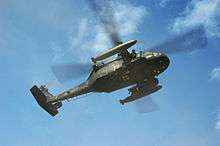
_17_assist_in_loading_fellow_Seabees_into_a_Blackhawk_medical_evacuation_helicopter_(MEDAVAC)_during_a_mass_casualty_drill.jpg)
- EH-60A Black Hawk: UH-60A with modified electrical system and stations for two electronic systems mission operators. All examples of type have been converted back to standard UH-60A configuration.[103]
- YEH-60B Black Hawk: UH-60A modified for special radar and avionics installations, prototype for stand-off target acquisition system.[103]
- EH-60C Black Hawk: UH-60A modified with special electronics equipment and external antenna.[103] (All examples of type have been taken back to standard UH-60A configuration.)
- EUH-60L (no official name assigned): UH-60L modified with additional mission electronic equipment for Army Airborne C2.[103]
- EH-60L Black Hawk: EH-60A with major mission equipment upgrade.[103]
- UH-60Q Black Hawk: UH-60A modified for medical evacuation.[103][113] The UH-60Q is named DUSTOFF for "dedicated unhesitating service to our fighting forces".[114]
- HH-60L (no official name assigned): UH-60L extensively modified with medical mission equipment.[103] Components include an external rescue hoist, integrated patient configuration system, environmental control system, on-board oxygen system (OBOGS), and crashworthy ambulatory seats.[113]
- HH-60M Black Hawk: UH-60M with medical mission equipment (medevac version) for U.S. Army.[103][115]
- HH-60U: USAF UH-60M version modified with an electro-optical sensor and rescue hoist. Three in use by Air Force pilots and special mission aviators since 2011. Has 85% commonality with the HH-60W.[116]
- HH-60W: Modified version of the UH-60M for the U.S. Air Force as a Combat Rescue Helicopter to replace HH-60G Pave Hawks with greater fuel capacity and more internal cabin space, dubbed the "60-Whiskey". Deliveries to begin in 2019.[117]
- MH-60A Black Hawk: 30 UH-60As modified with additional avionics, night vision capable cockpit, FLIR, M134 door guns, internal auxiliary fuel tanks and other Special Operations mission equipment in early 1980s for U.S. Army.[118][119] Equipped with T700-GE-701 engines.[103] Variant was used by the 160th Special Operations Aviation Regiment. The MH-60As were replaced by MH-60Ls beginning in the early 1990s and passed to the Air National Guard.[105][120]
- MH-60K Black Hawk: Special operations modification first ordered in 1988 for use by the U.S. Army's 160th Special Operations Aviation Regiment ("Night Stalkers").[105] Equipped with the in-flight refueling probe,[121] and T700-GE-701C engines. More advanced than the MH-60L, the K-model also includes an integrated avionics system (glass cockpit), AN/APQ-174B terrain-following radar, color weather map, improved weapons capability, and various defensive systems.[121][122]
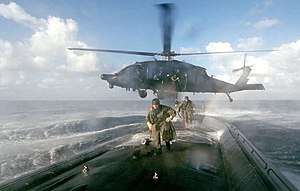
- MH-60L Black Hawk: Special operations modification, used by the U.S. Army's 160th Special Operations Aviation Regiment ("Night Stalkers"), based on the UH-60L with T700-701C engines. It was developed as an interim version in the late 1980s pending fielding of the MH-60K.[123] Equipped with many of the systems used on MH-60K, including FLIR, color weather map, auxiliary fuel system, and laser rangefinder/designator.[123][124] A total of 37 MH-60Ls were built and some 10 had received an in-flight refueling probe by 2003.[123]
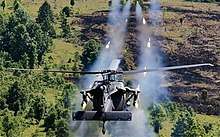
- MH-60L DAP: The Direct Action Penetrator (DAP) is a special operations modification of the baseline MH-60L, operated by the U.S. Army's 160th Special Operations Aviation Regiment.[125] The DAP is configured as a gunship, with no troop-carrying capacity. The DAP is equipped with ESSS or ETS stub wings, each capable of carrying configurations of the M230 Chain Gun 30 mm automatic cannon, 19-shot Hydra 70 rocket pod, AGM-114 Hellfire missiles, AIM-92 Stinger air-to-air missiles, GAU-19 gun pods, and M134 minigun pods,[126] M134D miniguns are used as door guns.[119]
- MH-60M Black Hawk: Special operations version of UH-60M for U.S. Army. Features the Rockwell Collins Common Avionics Architecture System (CAAS) glass cockpit and more powerful YT706-GE-700 engines.[127][128] All special operations Black Hawks to be modernized to MH-60M standard by 2015.[129]
- MH-60 Black Hawk stealth helicopter: One of two (known) specially modified MH-60s used in the raid on Osama bin Laden's hideout in Pakistan on 1 May 2011 was damaged in a hard landing, and was subsequently destroyed by U.S. forces.[130][131] Subsequent reports state that the Black Hawk destroyed was a previously unconfirmed, but rumored, modification of the design with reduced noise signature and stealth technology.[19][20] The modifications are said to add several hundred pounds to the base helicopter including edge alignment panels, special coatings and anti-radar treatments for the windshields.[20]
- UH-60A RASCAL: NASA-modified version for the Rotorcraft-Aircrew Systems Concepts Airborne Laboratory; a US$25M program for the study of helicopter maneuverability in three programs, Superaugmented Controls for Agile Maneuvering Performance (SCAMP), Automated Nap-of-the-Earth (ANOE) and Rotorcraft Agility and Pilotage Improvement Demonstration (RAPID).[132][133] The UH-60A RASCAL performed a fully autonomous flight on 5 November 2012. U.S. Army personnel were on board, but the flying was done by the helicopter. During a two-hour flight, the Black Hawk featured terrain sensing, trajectory generation, threat avoidance, and autonomous flight control. It was fitted with a 3D-LZ laser detection and ranging (LADAR) system. The autonomous flight was performed between 200 and 400 feet. Upon landing, the onboard technology was able to pinpoint a safe landing zone, hover, and safely bring itself down.[134]
.jpg)
- OPBH: On 11 March 2014, Sikorsky successfully conducted the first flight demonstration of their Optionally Piloted Black Hawk (OPBH), a milestone part of the company's Manned/Unmanned Resupply Aerial Lifter (MURAL) program to provide autonomous cargo delivery for the U.S. Army. The helicopter used the company's Matrix technology (software to improve features of autonomous, optionally-piloted VTOL aircraft) to perform autonomous hover and flight operations under the control of an operator using a man-portable Ground Control Station (GCS). The MURAL program is a cooperative effort between Sikorsky, the US Army Aviation Development Directorate (ADD), and the US Army Utility Helicopters Project Office (UH PO). The purpose of creating an optionally-manned Black Hawk is to make the aircraft autonomously carry out resupply missions and expeditionary operations, while increasing sorties and maintaining crew rest requirements and leaving pilots to focus more on sensitive operations.[135][136]
- VH-60D Night Hawk: VIP-configured HH-60D, used for Presidential transport by USMC. T700-GE-401C engines.[103] Variant was later redesignated VH-60N.[137]
- VH-60N White Hawk: Modified UH-60A with some features from the SH-60B/F Seahawks.[138] It is used for Presidential and VIP transport by USMC. It entered service in 1988 and nine were delivered.[138]
Export versions
- UH-60J Black Hawk: Variant for the Japanese Air Self Defense Force and Maritime Self Defense Force produced under license by Mitsubishi Heavy Industries. Also known as the S-70-12.[139]
- UH-60JA Black Hawk: Variant for the Japanese Ground Self Defense Force. It is license produced by Mitsubishi Heavy Industries.[139]
- AH-60L Arpía: Export version for Colombia developed by Elbit Systems, Sikorsky, and the Colombian Air Force. It is Counter-insurgency (COIN) attack version with improved electronics, firing system, FLIR, radar, light rockets and machine guns.[11][140]
- AH-60L Battle Hawk: Export armed version unsuccessfully tendered for Australian Army[11] project AIR87, similar to AH-60L Arpía III. Sikorsky has also offered a Battlehawk armed version for export in the form of armament kits and upgrades. Sikorsky's Armed Black hawk demonstrator has tested a 20 mm turreted cannon, and different guided missiles.[141][142] The United Arab Emirates ordered Battlehawk kits in 2011.[143]
- UH-60P Black Hawk: Version for South Korea Army, based on UH-60L with some improvements.[105] Around 150 were produced under license by Korean Air.[103][144][145]
S-70A
.jpg)
Sikorsky military model for the export market:
- S-70A-1 Desert Hawk: Export version for the Royal Saudi Land Forces.
- S-70A-L1 Desert Hawk: Aeromedical evacuation version for the Royal Saudi Land Forces.
- S-70A-5 Black Hawk: Export version for the Philippine Air Force.
- S-70A-6 Black Hawk: Export version for Thailand.
- S-70A-9 Black Hawk: Export version for Australia, assembled under licence by Hawker de Havilland. First eight delivered to the Royal Australian Air Force, subsequently transferred to the Australian Army; remainder delivered straight to the Army after rotary-wing assets divested by the Air Force in 1989.[146]
- S-70A-11 Black Hawk: Export version for the Royal Jordanian Air Force.
- S-70A-12 Black Hawk: Search and rescue model for the Japanese Air Self Defense Force and Maritime Self Defense Force. Also known as the UH-60J.
- S-70A-14 Black Hawk: Export version for Brunei.
- S-70A-16 Black Hawk: Engine test bed for the Rolls-Royce/Turbomeca RTM 332.
- S-70A-17 Black Hawk: Export version for Turkey.
- S-70A-18 Black Hawk: UH-60P and HH-60P for South Korea built under license.[147]
- Sikorsky/Westland S-70-19 Black Hawk: This version is built under license in the United Kingdom by Westland. Also known as the WS-70.
- S-70A-20 Black Hawk: VIP transport version for Thailand.
- S-70A-21 Black Hawk: Export version for Egypt.
- S-70A-22 Black Hawk: VH-60P for South Korea built under license. Used for VIP transport by the Republic of Korea Air Force. Its fuselage is tipped with white to distinguish from normal HH-60P.[148]
- S-70A-24 Black Hawk: Export version for Mexico.
- S-70A-26 Black Hawk: Export version for Morocco.
- S-70A-27 Black Hawk: Search and rescue version for the Hong Kong Government Flying Service; three built.
- S-70A-28D Black Hawk: Export version for Turkish Army.[149]
- S-70A-30 Black Hawk: Export version for Argentine Air Force, used as a VIP transport helicopter by the Presidential fleet; one built.[150]
- S-70A-33 Black Hawk: Export version for Royal Brunei Air Force.
- S-70A-39 Black Hawk: VIP transport version for Chile; one built.
- S-70A-42 Black Hawk: Export version for Austria.
- S-70A-43 Black Hawk: Export version for Royal Thai Army.
- S-70A-50 Black Hawk: Export version for Israel; 15 built.
- S-70C-2 Black Hawk: Export version for People's Republic of China; 24 built.[39]
- S-70i Black Hawk: International military version assembled by Sikorsky's subsidiary, PZL Mielec in Poland.[151]
- See Sikorsky SH-60 Seahawk, Sikorsky HH-60 Pave Hawk, Piasecki X-49, and Sikorsky HH-60 Jayhawk for other Sikorsky S-70 variants.
Military operators
- See SH-60 Seahawk, HH-60 Pave Hawk, HH-60 Jayhawk, and Sikorsky S-70 for operators of other H-60/S-70 family helicopters
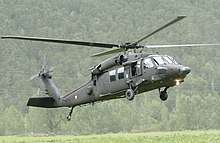
Albanian Air Force (3 on order)[153][154]
.jpg)
- Colombian Air Force[152]
- Colombian Army[152]
- Croatian Air Force (2 on order; 2 more planned)[152][155]
_copy.jpg)
- Japan Air Self-Defence Force[152]
- Japan Ground Self-Defence Force[152]
- Japan Maritime Self-Defence Force[152]
.jpg)
- Philippine Air Force (16 S-70i on order)[157][158][159]
- Polish Special Forces (4 S-70i on order)[160][161]
- Royal Saudi Air Force[152]
- Royal Saudi Land Forces[152]
- Saudi Arabian National Guard[152]
- Royal Saudi Navy[152]
.jpg)
.jpg)
- Turkish Air Force (6 T-70s on order)
- Turkish Army[152]
Accidents
From 1981 to 1984, 16 Black Hawks crashed with 22 deaths and the aircraft was grounded after.
On 3 March 1994, a UH-60 helicopter of the 15th Fighter Wing, Republic of Korea Air Force (ROKAF) exploded above Yongin, Gyeonggi-do, killing all of the six personnel on board, including General Cho Kun-hae, then Chief of the Air Staff of South Korea.[162]
On 14 April 1994, two U.S. Army UH-60 Black Hawks in northern Iraq were shot down by mistake by U.S. Air Force F-15s patrolling the northern no-fly zone that had been imposed after the 1991 Gulf War. 26 crew and passengers were killed.[163]
On 12 June 1996, two Australian Army Blackhawks collided during a SASR training exercise resulting in the death of 18 men - Fifteen members of the SASR and three from the 5th Aviation Regiment.[164][165][166]
On 10 March 2015, a UH-60 from Eglin Air Force Base crashed off the coast of the Florida Panhandle near the base. All 11 on board were killed.[167]
On 5 December 2019, a UH-60 from the Minnesota Army National Guard Army Aviation Support Facility in St. Cloud, MN crashed shortly after taking off on a maintenance test flight, killing all 3 men on board. https://www.fox9.com/news/3-soldiers-confirmed-dead-in-minnesota-national-guard-black-hawk-helicopter-crash
On 2 January 2020, a UH-60M helicopter of the Republic of China Air Force (ROCAF) in Taiwan, crashed on a mountainside, killing 8 people on board, including General Shen Yi-ming, chief of the general staff of Taiwan’s armed forces.[168]
Specifications (UH-60M)
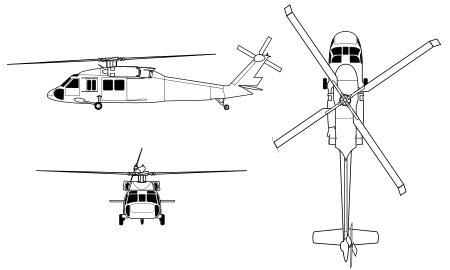
Data from Encyclopedia of Modern Warplanes,[169] International Directory,[170] Black Hawk[171]
General characteristics
- Crew: 2 flight crew + 2 loadmaster/gunners
- Capacity: 2,640 lb (1,200 kg) of cargo internally, including 11 troops or 6 stretchers, or 9,000 lb (4,100 kg) of cargo externally
- Length: 64 ft 10 in (19.76 m) including rotors
- Fuselage length: 50 ft 1 in (15.27 m)
- Width: 7 ft 9 in (2.36 m)
- Height: 16 ft 10 in (5.13 m)
- Empty weight: 10,624 lb (4,819 kg)
- Max takeoff weight: 23,500 lb (10,659 kg)
- Powerplant: 2 × General Electric T700-GE-701C turboshaft engines, 1,890 shp (1,410 kW) each
- Main rotor diameter: 53 ft 8 in (16.36 m)
- Main rotor area: 2,260 sq ft (210 m2)
- Blade section: root: Sikorsky SC2110 ; tip: Sikorsky SSC-A09[172]
Performance
- Maximum speed: 159 kn (183 mph, 294 km/h)
- Cruise speed: 150 kn (170 mph, 280 km/h)
- Never exceed speed: 193 kn (222 mph, 357 km/h)
- Combat range: 320 nmi (370 mi, 590 km)
- Ferry range: 1,199 nmi (1,380 mi, 2,221 km) with ESSS stub wings and external tanks[171]
- Service ceiling: 19,000 ft (5,800 m)
- Rate of climb: 1,315 ft/min (6.68 m/s) [173]
- Disk loading: 7.19 lb/sq ft (35.1 kg/m2)
- Power/mass: 0.192 shp/lb (0.316 kW/kg)
Armament
- Guns:
- 2 × 7.62 mm (0.30 in) M240 machine guns[174]
- 2 × 7.62 mm (0.30 in) M134 minigun[171] or
- 2 × 12.7 mm (0.50 in) GAU-19 gatling guns[171]
- Hardpoints: 4, 2 per ESSS stub wings with provisions to carry combinations of:
- Rockets: 70 mm (2.75 in) Hydra 70 unguided rockets in either a 7 tube (M260) or 19 tube (M261) pod.[171]
- Missiles: Up to 4xAGM-114 Hellfire laser guided air-to-ground missiles or 2xAIM-92 Stinger heat seeking air-to-air missiles per hardpoint. The Hellfire launcher rails can also be equipped with M260 (7 tube) Hydra pods.[126][171]
- Other: 7.62 mm (0.30 in), 12.7 mm (0.50 in), 20 mm (0.787 in), or 30 mm (1.18 in) M230 gun pods[171]
- Bombs: Can be equipped with VOLCANO minefield dispersal system.[171] See UH-60 Armament Subsystems for more information.
See also
Related development
- Sikorsky S-70
- Sikorsky HH-60 Pave Hawk
- Sikorsky HH-60 Jayhawk
- Sikorsky SH-60 Seahawk
- Piasecki X-49
- Sikorsky S-92 / Sikorsky CH-148 Cyclone
Aircraft of comparable role, configuration and era
- AgustaWestland AW149
- Bell CH-146 Griffon
- Bell UH-1 Iroquois
- Bell UH-1N Twin Huey
- Bell UH-1Y Venom
- Boeing-Vertol YUH-61
- Denel Oryx
- Eurocopter AS532 Cougar
- Harbin Z-20
- KAI Surion
- Mil Mi-8/Mil Mi-17
- NHIndustries NH90
Related lists
- List of helicopters
- List of utility helicopters
- List of active military aircraft of the United States
- List of Sikorsky S-70 Models
References
Notes
- According to an Army Times article, "During the 1990s U.S. Special Operations Command worked with the Lockheed Martin Skunk Works division, which also designed the F-117, to refine the radar-evading technology and apply it to the 160th Special Operations Aviation Regiment’s MH-60s, [a retired special operations aviator] said. USSOCOM awarded a contract to Boeing to modify several MH-60s to the low-observable design "in the ’99 to 2000 timeframe," he also said.
Citations
- "Sikorsky finally gets its own Blackhawk." Archived 25 August 2012 at the Wayback Machine ctpost.com. Retrieved: 24 October 2012.
- "United States Department of Defense Fiscal Year 2012 Budget Request: Program Acquisition Costs by Weapon System", p. 1-13." Office of the Under Secretary of Defense (Comptroller)/CFO. February 2011.
- Leoni 2007, pp. 8–10.
- Leoni 2007, pp. 11, 39.
- Leoni 2007, pp. 39, 42–43.
- Leoni 2007, pp. 42–48.
- Leoni 2007, p. 165.
- Eden, Paul. "Sikorsky H-60 Black Hawk/Seahawk", Encyclopedia of Modern Military Aircraft. Amber Books, 2004. ISBN 1-904687-84-9.
- Tomajczyk 2003, pp. 15–29.
- Leoni 2007, pp. 217–218.
- Bishop 2008.
- "Pentagon Acquisition Panel Authorizes UH-60M BLACK HAWK Low Rate Initial Production." Archived 28 September 2011 at the Wayback Machine Sikorsky Aircraft, 4 April 2005.
- Leoni 2007, pp. 233–236.
- "Sikorsky Aircraft Delivers First New Production UH-60M BLACK HAWK Helicopter to U.S. Army." Archived 28 September 2011 at the Wayback Machine Sikorsky Aircraft, 31 July 2006.
- "UH-60 Black Hawk Sikorsky S-70A – Multi-Mission Helicopter." Archived 9 June 2007 at the Wayback Machine Army-Technology.com'. Retrieved: 24 October 2012.
- "Sikorsky Aircraft Delivers 100th New Production UH-60M BLACK HAWK Helicopter to U.S. ..." Archived 5 May 2009 at the Wayback Machine Reuters, 25 March 2009.
- Parsons, Dan (19 November 2014), "US awards Sikorsky $1.3 billion in helicopter contracts", Flightglobal, Reed Business Information, archived from the original on 19 November 2014, retrieved 19 November 2014
- "US used never-seen-before stealth helicopters for Osama raid." Archived 6 May 2011 at the Wayback Machine ndtv.com, 5 May 2011. Retrieved: 5 May 2011.
- Ross, Brian, Rhonda Schwartz, Lee Ferran and Avni Patel. "Top Secret Stealth Helicopter Program Revealed in Osama Bin Laden Raid: Experts." Archived 5 May 2011 at the Wayback Machine ABC World News, 4 May 2011.
- Naylor, Sean D. "Army mission helicopter was secret, stealth Black Hawk." Army Times, 4 May 2011. Retrieved: 7 May 2011.
- "Structural Concepts and Aerodynamic Analysis for Low Radar Cross Section (LRCS) Fuselage Configurations." Archived 17 July 2011 at the Wayback Machine dtic.mil. Retrieved: 23 August 2011.
- "Sikorsky awarded contract to integrate and test enhanced Black Hawk helicopter capabilities." Archived 2 October 2012 at the Wayback Machine Sikorsky press release, 18 September 2012.
- "Future Vertical Lift: Have Plan, Need Money" Archived 25 March 2016 at the Wayback Machine. Aviationtoday.com, 1 July 2012.
- Adding new punch to aerial deliveries Archived 12 October 2015 at the Wayback Machine - Army.mil, 16 August 2013
- Picatinny 'Speed Bag' resupplies Soldiers with less equipment damage Archived 26 October 2015 at the Wayback Machine - Army.mil, 25 June 2014
- The enhanced speed bag system Archived 19 September 2015 at the Wayback Machine - Army.mil, 7 July 2015
- Harding, Stephen. "Sikorsky H-60 Black Hawk". U.S. Army Aircraft Since 1947. Atglen, Pennsylvania: Schiffer Publishing Ltd., 1997. ISBN 0-7643-0190-X.
- Leoni 2007
- "VH-60." Archived 10 February 2007 at the Wayback Machine Global Security. Retrieved: 24 October 2012.
- "Preliminary Airworthiness Eval of UH-60A Configured with ESSS." Archived 4 June 2011 at the Wayback Machine US DoD. Retrieved: 24 October 2012.
- TFM 3-04.500 "Army Aviation Maintenance, Appendix G, US Department of the Army, 26 September 2000." Archived 1 June 2009 at the Wayback Machine GlobalSecurity.org. Retrieved: 15 April 2009.
- "H-60 Black Hawk Crashworthy External Fuel System (CEFS)" (PDF). Robertson Fuel Systems. July 2010. Retrieved 18 November 2013.
- "Preliminary Airworthiness Eval of UH-60A/ESSS with Hellfire Missile Launcher Installed." Archived 4 June 2011 at the Wayback Machine DTIC.mil. Retrieved: 24 October 2012.
- "H-60." Archived 13 April 2006 at the Wayback Machine Global Security. Retrieved: 24 October 2012.
- Australia grounds Black Hawk helicopter fleet 25 April 2012 Archived 17 January 2018 at the Wayback Machine The Telegraph Retrieved 22 May 2016
- Chipperfield, Mark Australian warship secretly despatched to Solomon Islands 11 June 2000 Archived 17 January 2018 at the Wayback Machine The Telegraph Retrieved 22 May 2016
- Black Hawk combat choppers denied Afghan Aussie troops 29 November 2014 The Australian Retrieved 22 May 2016
- "Brazil Buys UH-60L Black Hawks". Defense Industry Daily. 9 September 2012. Archived from the original on 15 June 2009. Retrieved 6 March 2010.
- Leoni 2007, pp. 286-292.
- Leoni 2007, pp. 270–273.
- Arpía Archived 3 October 2018 at the Wayback Machine. SpanishDict.com. Retrieved on 30 September 2009. "Arpía [ar-pee’-ah] noun 1. (Poetic.) Harpy, a bird of prey represented by poets. (f)"
- "SIKORSKY -Colombia Takes Delivery of First S-70i BLACK HAWK Helicopters with Terrain Awareness and Warning Capability". HispanicBusiness.com. 21 October 2013. Archived from the original on 29 October 2013. Retrieved 16 November 2013.
- "La Policía de Colombia compró 10 helicópteros UH-60A Black Hawk". webinfomil.com. 11 March 2017. Archived from the original on 20 March 2017. Retrieved 19 March 2017. (in Spanish)
- Leoni 2007, pp. 278–279.
- "Sikorsky UH-60 / S-70 Blackhawk (Yanshuf)." Archived 3 June 2016 at the Wayback Machine Jewish Virtual Library Retrieved: 18 November 2013.
- "Aztec Rotors – Helicopters of Mexican Air Force". acig.org. Archived from the original on 22 June 2009. Retrieved 24 October 2012.
- "Mexico sends 1,000 more police to drug area". NBC News. 16 July 2009. Retrieved 26 September 2009.
- "Mexican police arrest 34 drug cartel suspects". CNN. 3 August 2009. Archived from the original on 7 August 2009. Retrieved 26 September 2009.
- "Blackhawks ready to fly for the Mexican Navy". app.com. 25 August 2011.
- "Major Arms Sales". dsca.mil. Archived from the original on 24 April 2014. Retrieved 21 April 2014.
- "Sikorsky's $8.5-11.7B "Multi-Year 8" H-60 Helicopter Contract". Defense Industry Daily. 18 March 2015. Archived from the original on 24 September 2014. Retrieved 19 September 2014.
- "Slovakia – UH-60M Black Hawk Helicopters". Defense Security Cooperation Agency. Archived from the original on 24 April 2015. Retrieved 3 May 2015.
- "State OK's Slovakia UH-60 Deal". Defense News, 20 February 2015.
- "Slovakia considering US Black Hawk offer". Janes.com. 14 January 2015. Archived from the original on 7 September 2015. Retrieved 30 July 2015.
- Archived 22 August 2015 at the Wayback Machine Jane's
- "Contracts for September 3, 2015". Archived from the original on 1 March 2017. Retrieved 1 May 2017.
- "Slovakia shows off new Black Hawk". 6 September 2017. Archived from the original on 7 September 2017. Retrieved 15 December 2017.
- TeamAirsoc. "SLOVAKIA SHOWS OFF NEW BLACK HAWK - airsoc.com".
- "Exclusive shots: The last three new Black Hawks from America landed in Presov". tvnoviny.sk. 11 January 2020.
- "Sweden makes surprise Black Hawk request". Flightglobal.com. Archived from the original on 5 December 2013. Retrieved 7 October 2010.
- "Sweden Ordering H-60M Helicopters for Afghan CSAR/MEDEVAC". Defense Industry Daily. 16 July 2012. Archived from the original on 5 May 2011.
- av: Lasse Jansson. "Helikopter 16 på väg till Afghanistan - Försvarsmakten". Forsvarsmakten.se. Archived from the original on 18 April 2013. Retrieved 16 November 2013.
- "Sverige köper 15 Black Hawk-helikoptrar". expressen.se. 9 April 2011. Archived from the original on 11 April 2011. Retrieved 9 April 2011. (English translation) Archived 2 March 2016 at the Wayback Machine
- "ROCAF Sikorsky S-70C Bluehawk". Taiwanairpower.org. 11 November 2008. Archived from the original on 27 February 2010. Retrieved 2 March 2010.
- "Sikorsky S-70C(M) Thunderhawk". Taiwanairpower.org. April 2008. Archived from the original on 5 June 2010. Retrieved 2 March 2010.
- Govindasamy, Siva (31 January 2010). "USA okays Black Hawks for Taiwan, Beijing mulls sanctions". Flight International. Archived from the original on 7 February 2010. Retrieved 2 March 2010.
- "52 Black Hawk helicopters grounded after fatal crash". Taiwanairpower.org. 2 January 2020. Retrieved 2 January 2020.
- "Turkey to decide in June between AW149, 'T-70' Black Hawk". Flight International. 9 April 2009. Archived from the original on 4 March 2016. Retrieved 31 January 2019.
- "TAI to procure more helicopters for security". Today's Zaman. 6 April 2009.
- "Milyarlık helikopter ihalesi Skorsky'nin". Istanbulhaber. 21 April 2011. Archived from the original on 15 July 2011. Retrieved 21 April 2011.
- "Turkey Picks Sikorsky Helo in $3.5B Deal". Defense News. 21 April 2011. Retrieved 24 September 2011.
- "Sikorsky wins Turkish utility helicopter battle". Flightglobal.com. Archived from the original on 27 April 2011. Retrieved 24 September 2011.
- "Turkish Soldiers Fly To Greece For Asylum". Archived from the original on 22 August 2016. Retrieved 10 August 2016.
- "Turkey coup attempt: Greek dilemma over soldiers who fled". BBC. 19 July 2016. Archived from the original on 25 August 2018. Retrieved 20 June 2018.
- Goebel, Greg. "S-70 Origins: UTTAS". Air Vector. Archived from the original on 6 October 2014. Retrieved 18 November 2013.
- "Black Hawks." Archived 25 October 2010 at the Wayback Machine armyaircrews.com. Retrieved: 24 October 2012.
- Page, Lewis. "Sikorsky, US Army claim whisper-flapcopter test success." Archived 10 August 2017 at the Wayback Machine The Register, 5 May 2011.
- "Political punch: Obama gives order, Bin Laden is killed; White House time line." Archived 10 July 2015 at the Wayback Machine ABC News, May 2011.
- "Bin Laden raid: China 'viewed US helicopter wreckage'". BBC.com. BBC. 15 August 2011. Archived from the original on 15 August 2011. Retrieved 15 August 2011.
- "Reports: Pakistan let Chinese inspect U.S. stealth copter." Archived 18 September 2012 at the Wayback Machine CNN.com, 15 August 2011. Retrieved: 15 August 2011.
- "Report: Pakistan Granted China Access to U.S.'s Top-Secret Bin Laden Raid Chopper." Archived 6 November 2018 at the Wayback Machine FoxNews.com, 15 August 2011. Retrieved: 15 August 2011.
- "United Arab Emirates – UH-60M Black Hawk Helicopters" (PDF). US Defense Security Cooperation Agency. 9 September 2008. Archived from the original (PDF) on 27 May 2011.
- "Dubai Helishow: UAE increases Black Hawk fleet". Rotorhub. 2 November 2010. Archived from the original on 6 August 2012. Retrieved 1 January 2014.
- "Selected Acquisition Report - UH-60M Black Hawk" (PDF). US Department of Defense. 31 December 2011. p. 18. Archived from the original (PDF) on 16 September 2012.
- "Conventional Arms Transfers to Developing Nations, 2003-2010" (PDF). Congressional Research Service. p. 7. Archived (PDF) from the original on 10 August 2012. Retrieved 24 October 2012.
- "Brunei receives first S-70i helicopters". IHS Jane's Defence Weekly. 4 December 2013. Archived from the original on 10 December 2013. Retrieved 16 March 2014.
- "Qatar – UH-60M Black Hawk Helicopters" (PDF). US Defense Security Cooperation Agency. 13 June 2012. Archived from the original (PDF) on 11 July 2012. Retrieved 4 July 2012.
- "Indonesia to purchase UH-60 Black Hawk helicopters". Airrecognition.com. 26 February 2013. Archived from the original on 21 August 2013. Retrieved 2 March 2013.
- "black Hawke". jutarnji.hr. Archived from the original on 8 April 2016. Retrieved 27 May 2014.
- "Predstavljeni helikopteri Black Hawk UH-60M". morh.hr. Archived from the original on 12 October 2018. Retrieved 12 October 2018.
- "Tunisia – UH-60M Black Hawk Helicopters" Archived 27 July 2014 at the Wayback Machine. DSCA, 24 July 2014.
- Archived 19 August 2014 at the Wayback Machine tap.info.tn
- Abas, Marhalim (23 January 2015). "RMAF getting Brunei Blackhawks". Malaysian Defence. Archived from the original on 22 March 2015. Retrieved 25 January 2015.
- Archived 6 August 2018 at the Wayback Machine. DSCA
- Jennings, Gareth (30 November 2018). "Latvia signs for Black Hawk helos". IHS Jane's 360. Berlin. Archived from the original on 30 November 2018. Retrieved 3 December 2018.
- "Archived copy". Archived from the original on 14 December 2018. Retrieved 7 December 2018.CS1 maint: archived copy as title (link)
- PH to purchase US-made Black Hawk helicopters
- https://www.asiapacificdefensejournal.com/2019/06/philippines-orders-16-sikorsky-s-70i.html
- https://www.army-technology.com/news/lithuania-uh-60m-black-hawk-us/
- "Four Black Hawk Helicopters for Poland By the End of 2019 - Defence24.com". www.defence24.com. Retrieved 25 December 2019.
- "Black Hawk." Archived 14 June 2007 at the Wayback Machine U.S. Army Fact Files. Retrieved: 2 June 2010.
- DoD 4120-15L, "Model Designation of Military Aerospace Vehicles," Archived 25 October 2007 at the Wayback Machine DoD, 12 May 2004.
- "Sikorsky S-70 (H-60) Upgrades". (online subscription article) Jane's Aircraft Upgrades, 16 April 2012.
- Donald, David, ed. "Sikorsky S-70". The Complete Encyclopedia of World Aircraft. New York: Barnes & Noble Books, 1997. ISBN 0-7607-0592-5.
- Leoni 2007, pp. 217–224.
- "SNC Submits Sierra Force™ Helicopter in Final Bid for UH-1N Replacement Program" (Press release). Sierra Nevada Corporation. 23 July 2018. Archived from the original on 30 July 2018. Retrieved 30 July 2018.
- "Northrop To Upgrade U.S. Army UH-60L Cockpits", Aviation week, 15 August 2014, archived from the original on 19 August 2014, retrieved 18 August 2014.
- Leoni 2007, pp. 233–244.
- "Sikorsky Aircraft Fully Equips First U.S. Army Unit With UH-60M BLACK HAWK Helicopters." Archived 25 July 2011 at the Wayback Machine Sikorsky Aircraft, 10 June 2008.
- "Sikorsky's UH-60M Upgrade Black Hawk Helicopter Achieves First Flight." Archived 27 February 2012 at the Wayback Machine Sikorsky, 29 August 2008.
- "New Army Black Hawk succeeds in combat." US Army, 4 March 2010
- Colucci, Frank. "Modern Medevac Mobilized." Archived 25 December 2011 at the Wayback Machine Rotor & Wing, 1 October 2004.
- Leoni 2007, p. 224.
- "HH-60M Medevac Helicopter." Archived 19 July 2015 at the Wayback Machine Sikorsky. Retrieved: 1 August 2015.
- "Sikorsky pitches HH-60Us to replace USAF Hueys", Flight global, 28 February 2017, archived from the original on 7 March 2017, retrieved 6 March 2017.
- "'Whiskey' to perform personnel recovery mission" Archived 29 November 2014 at the Wayback Machine. AF, 24 November 2014.
- Tomajczyk 2003, pp. 21–23.
- Bishop 2008, pp. 20, 22.
- Tomajczyk 2003, p. 23.
- Tomajczyk 2003, pp. 26–29.
- "Sikorsky S-70A/H-60." (online subscription article) Jane's Helicopter Markets and Systems, 31 March 2011.
- Tomajczyk 2003, pp. 23–26.
- MH-60 Black Hawk fact sheet, 160th SOAR, archived from the original on 31 October 2010
- "160th Special Operations Aviation Regiment (Airborne)". US Army Special Operations Command. Archived from the original on 11 December 2013. Retrieved 18 November 2013.
- "MH-60L DAP". American special ops. Archived from the original on 29 October 2012. Retrieved 27 January 2013.
- "Sikorsky S-70 (H-60) – US Army MH-60 Upgrades" (online subscription article). Jane's Aircraft Upgrades, 2008, 11 June 2008.
- "Sikorsky S-70 (H-60) Upgrades" (online subscription article). Jane's Aircraft Upgrades, 3 May 2011.
- Superfast Helicopters Archived 31 March 2013 at the Wayback Machine - Defensemedianetwork.com, 25 October 2011
- "The Secret Team That Killed bin Laden", National Journal, 3 May 2011, archived from the original on 24 May 2012.
- "Helicopter Loss in bin Laden Raid Highlights Risk." Archived 24 September 2015 at the Wayback Machine Reuters, 3 May 2011.
- "NASA, Army Research More Maneouverable Helicopters." Archived 16 October 2007 at the Wayback Machine Ames Research Center, 4 April 1992.
- "Image of UH-60A RASCAL first flight". NASA. Archived from the original on 26 November 2006. Retrieved 17 February 2012..
- "Autonomous Black Hawk Flight System Trialled". Armed forces International, 6 December 2012.
- "Sikorsky achieves first flight of manned/unmanned Black Hawk", Flight global, 23 April 2014, archived from the original on 26 April 2014, retrieved 23 April 2014.
- Optionally Piloted Black Hawk takes off, Shephard media, 23 April 2014, archived from the original on 4 June 2015, retrieved 23 April 2014.
- Bishop 2008, p. 45.
- Leoni 2007, pp. 214–15.
- "Mitsubishi Heavy Industries UH-60J page." Archived 27 September 2011 at the Wayback Machine Mhi.co.jp, 31 March 2005. Retrieved: 24 September 2011.
- Leoni 2007, pp. 270–272.
- "Armed BLACK HAWK Demonstrator Completes Test Program Customer Demo Shows Sikorsky Helicopter’s Weapons in Action" Archived 3 December 2013 at the Wayback Machine. Sikorsky, 14 December 2009.
- Battlehawk Archived 17 October 2017 at the Wayback Machine. Sikorsky public relations video, 2012.
- "UAE Seeks Weaponized UH-60M ‘Battlehawk’ Helicopters" Archived 21 September 2008 at the Wayback Machine. DefenseIndustryDaily.com, 12 January 2012.
- "Korean Air/Sikorsky announce Black Hawk production agreement. (UH-60P military helicopters) – Defense Daily |HighBeam Research – FREE trial." Encyclopedia.com. Retrieved: 24 September 2011. Archived 13 July 2011 at the Wayback Machine
- Pike, John, ed. "Korean Air Aerospace Division (KAA)." Archived 8 September 2009 at the Wayback Machine Globalsecurity.org. Retrieved: 4 September 2011.
- "ADF Serials list of Australian Black Hawks." Archived 7 June 2011 at the Wayback Machine ADF Serials. Retrieved: 19 June 2010.
- "South Korean HH-60P photos." airliners.net. Retrieved: 24 September 2011.
- VH-60P 02351 image Archived 14 July 2011 at the Wayback Machine, "VH60P 02352 image." Archived 14 July 2011 at the Wayback Machine mamboccv.com. Retrieved: 24 October 2012.
- "Archived copy". Archived from the original on 10 September 2016. Retrieved 20 November 2018.CS1 maint: archived copy as title (link)
- "Argentine pic & video." Archived 11 June 2011 at the Wayback Machine helis.com. Retrieved: 24 October 2012.
- "Sikorsky breathes new life into PZL Mielec." Archived 11 June 2010 at the Wayback Machine Flight International, 8 June 2010.
- "World Air Forces 2019". Flightglobal Insight. 2019. Archived from the original on 23 January 2019. Retrieved 4 December 2018.
- Bozinovski, Igor (16 April 2019). "Albania to receive surplus US Black Hawks". Jane's 360. Skopje. Archived from the original on 16 April 2019. Retrieved 16 April 2019.
- "Albania Gets Second Hand Black Hawk from USA". C4 Defence. 11 April 2019. Archived from the original on 16 April 2019. Retrieved 16 April 2019.
- Jennings, Gareth (30 October 2019). "Croatia cleared to buy Black Hawks". IHS Jane's.
- "Royal Moroccan Gendarmerie S-70 C/N 70-1747". helis.com. Archived from the original on 2 February 2014. Retrieved 12 March 2013.
- "PHILIPPINES ORDERS 16 SIKORSKY S-70I BLACK HAWK UTILITY HELICOPTERS". Asia Pacific Defense journal.
- "World Military Aircraft Inventory". 2018 Aerospace. Aviation Week and Space Technology, January 2018.
- "World Air Forces 2004 pg. 80". flightglobal.com. November 2004. Archived from the original on 11 May 2013. Retrieved 10 August 2014.
- Perry, Dominic (25 January 2019). "Poland courts controversy with single-source helicopter buy". FlightGlobal. London. Archived from the original on 26 January 2019. Retrieved 2 February 2019.
- Wilk, Remigiusz (29 January 2019). "Poland orders four Sikorsky S-70i helicopters". Jane's 360. Warsaw. Archived from the original on 29 January 2019. Retrieved 2 February 2019.
- "趙공군총장 헬機폭발 사망 어제 오후" [General Cho, Chief of the Air Staff, died in helicopter explosion yesterday afternoon] (in Korean). Dong-a Ilbo. 4 March 1994. p. 1.
- Howe Verhovek, Sam (21 June 1995). "Air Force Officer Is Acquitted In Downing of Army Aircraft". New York Times. Archived from the original on 26 October 2017. Retrieved 26 October 2017.
- "Black Hawk tragedy: Survivor remembers worst peacetime military aviation disaster 20 years on". ABC News. 13 June 2016. Retrieved 28 December 2019.
- "Accident Sikorsky S-70A-9 (CH-60) A25-113, 12 Jun 1996". 6 March 2010. Retrieved 28 December 2019.
- "Accident Sikorsky S-70A-9 (CH-60) A25-209, 12 Jun 1996". 6 March 2010. Retrieved 28 December 2019.
- Botelho, Greg (11 March 2015). "U.S. military helicopter crashes off northwest Florida; human remains found". CNN. Archived from the original on 11 March 2015. Retrieved 11 March 2015.
- Ramzy, Austin (2 January 2020). "Taiwan's Top Military Official and 7 Others Die in Helicopter Crash". The New York Times. ISSN 0362-4331. Retrieved 2 January 2020.
- Gunston, Bill. The Encyclopedia of Modern Warplanes. London: Aerospace Publishing Ltd, 1995. ISBN 1-56619-908-5.
- Frawley, Gerald. The International Directory of Military Aircraft, 2002/2003. Fyshwick, ACT, Australia: Aerospace Publications, 2002. ISBN 1-875671-55-2.
- Tomajczyk 2003, pp. 11, 14–15.
- Lednicer, David. "The Incomplete Guide to Airfoil Usage". m-selig.ae.illinois.edu. Retrieved 16 April 2019.
- "Weapons Systems 2011." Archived 12 August 2012 at the Wayback Machine U.S. Army. Retrieved: 24 October 2012.
- Bishop 2008, p. 11.
Bibliography
- Bishop, Chris. Sikorsky UH-60 Black Hawk. Oxford, UK: Osprey, 2008. ISBN 978-1-84176-852-6.
- Leoni, Ray D. Black Hawk, The Story of a World Class Helicopter. Reston, Virginia: American Institute of Aeronautics and Astronautics, 2007. ISBN 978-1-56347-918-2.
- Tomajczyk, Stephen F. Black Hawk. St. Paul, Minnesota: MBI, 2003. ISBN 0-7603-1591-4.
External links
| Wikimedia Commons has media related to UH-60 Black Hawk. |
| External image | |
|---|---|
| Sikorsky UH-60A Black Hawk cut-out showing internal components | |
- UH/HH-60 Black Hawk U.S. Army page
- Lockheed Martin's BLACK HAWK page
- YUH-60A cutaway image on flightglobal.com
- UTTAS program, origin of the Black Hawk on helis.com
- UH-60A, H-60, AH-60L and Sikorsky S-70 GlobalSecurity.org
- UH-60 Blackhawk medium size utility helicopter(Air recognition)
- S-70A-42 Black Hawk of the Austrian Army
- Military.com with data on range extending devices
- UH-60 Black Hawk on kamov.net
